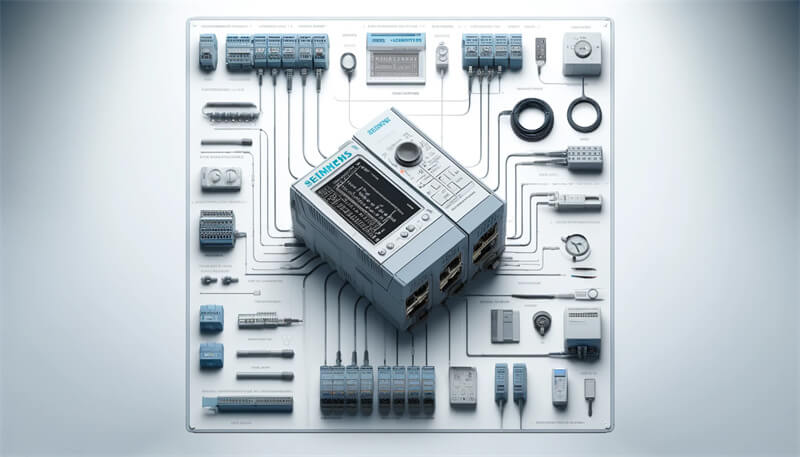Key Takeaways
| Question | Answer |
|---|---|
| What is Siemens S7-1200 PLC? | A programmable logic controller used in industrial automation for various control tasks. |
| Why use Ethernet for connection? | Provides reliable, fast, and secure communication for industrial networks. |
| Required Components | Siemens S7-1200 PLC, Ethernet cables, network switch/router, computer, TIA Portal software. |
| Basic Steps for Connection | Set up hardware, configure IP address, establish communication using TIA Portal, troubleshoot issues. |
| Common Issues & Solutions | IP conflicts, incorrect network settings, use of diagnostic tools for troubleshooting. |
| Advanced Setup Options | Open User Communication (OUC), wireless network setup, connecting additional devices. |
Introduction
At ControlNexus, established in 2013, we pride ourselves on being a leading provider of Siemens PLCs, HMIs, and Inverters. One of the most frequently asked questions we receive is how to connect the Siemens S7-1200 PLC via Ethernet. This guide will walk you through the process step-by-step, ensuring you can set up your PLC quickly and efficiently.
Understanding the Basics
What is Ethernet and Why Use It?
Ethernet is a widely used network technology that provides a reliable and fast means of communication. In industrial settings, using Ethernet to connect your Siemens S7-1200 PLC ensures secure and efficient data transfer, which is crucial for maintaining the smooth operation of automated systems.
Components Required
To connect your Siemens S7-1200 PLC via Ethernet, you will need the following components:
- Siemens S7-1200 PLC
- Ethernet cables
- Network switch or router
- Computer with TIA Portal software installed
Setting Up the Hardware
Connecting the PLC to Your Network
- Physical Connections:
- Connect an Ethernet cable from your Siemens S7-1200 PLC to the network switch or router.
- Connect another Ethernet cable from your computer to the same network switch or router.
- Powering Up:
- Ensure all devices, including the PLC, network switch, and computer, are powered on and properly connected.
Configuring the IP Address
Using TIA Portal
- Open TIA Portal:
- Launch the TIA Portal software on your computer.
- Create a New Project:
- Navigate to “Create new project” and enter the necessary project details.
- Adding the PLC:
- In the project view, select “Add new device” and choose your Siemens S7-1200 PLC model.
- Assigning IP Address:
- Go to the “Devices & networks” tab and select your PLC.
- Under the Ethernet interface settings, assign a static IP address to the PLC. Ensure this IP address does not conflict with other devices on your network.
- Saving and Compiling:
- Save your settings and compile the project to apply the IP configuration to the PLC.
Establishing Communication
Basic Communication Setup
- Configuring Profinet Settings:
- In TIA Portal, configure the Profinet settings to establish basic communication between your PLC and other network devices.
- Verifying Connection:
- Use the “Online” feature in TIA Portal to check the connection status of your PLC. Ensure the PLC is correctly recognized and communicating with the network.
Troubleshooting Common Issues
Common Connection Problems
- IP Address Conflicts:
- Verify that the assigned IP address is unique within your network to avoid conflicts.
- Network Configuration Issues:
- Double-check your network settings in TIA Portal and ensure they match the settings of your network switch or router.
- Using Diagnostic Tools:
- Utilize the diagnostic tools in TIA Portal to identify and resolve connection issues.
Advanced Communication Setup
Open User Communication (OUC)
For advanced users, setting up Open User Communication (OUC) can provide greater flexibility and control over your network communication.
- Configuration Steps:
- Detailed configuration steps for OUC can be found in the Siemens documentation, providing instructions on setting up and managing open communications.
Wireless Network Setup
- Connecting to a Wireless Network:
- Follow a detailed example to set up a PLC connection over a wireless network. Ensure you configure the wireless settings correctly to maintain a stable connection.
Advanced Communication Setup
Open User Communication (OUC)
For advanced users looking to enhance their PLC communication capabilities, Open User Communication (OUC) offers a flexible solution. OUC allows for customized communication protocols over Ethernet, enabling advanced data exchange between Siemens PLCs and other network devices.
Configuration Steps:
- Access the Communication Settings:
- Open your project in TIA Portal and navigate to the PLC device configuration.
- Select the “Communication” tab to access OUC settings.
- Configure Communication Blocks:
- Use the TCON, TSEND_C, and TRCV_C blocks to establish and manage OUC connections.
- Set the necessary parameters for each block, including IP addresses, ports, and communication protocols.
- Implementing the Communication Logic:
- Program the communication logic in the PLC’s ladder logic or structured text.
- Ensure proper error handling and data verification mechanisms are in place.
- Testing and Validation:
- Compile and download the configuration to the PLC.
- Use diagnostic tools in TIA Portal to monitor and validate the communication process.
Example Use Case: Implementing OUC can be beneficial in scenarios where custom protocols are required, such as integrating third-party devices or systems with unique communication requirements.
Wireless Network Setup
In certain industrial environments, a wireless network setup may be necessary to connect Siemens S7-1200 PLCs. This section provides a detailed example of setting up a PLC connection over a wireless network.
Step-by-Step Guide:
- Initial Setup:
- Connect your PLC directly to a computer using an Ethernet cable.
- Configure the PLC’s IP address as described in the basic setup section.
- Wireless Network Configuration:
- Connect the PLC to a wireless access point using an Ethernet cable.
- Configure the access point with the same network settings used for the PLC.
- Establishing Wireless Communication:
- On your computer, connect to the wireless network.
- Use TIA Portal to detect the PLC over the wireless network by searching for its IP address.
- Troubleshooting Wireless Issues:
- Ensure there are no IP address conflicts within the wireless network.
- Verify the wireless signal strength and stability.
Example Use Case: A common application for wireless network setups includes connecting remote sensors or devices that are not easily accessible via wired connections.
Real-World Examples
To provide a better understanding of practical applications, let’s explore some real-world examples of connecting Siemens S7-1200 PLCs via Ethernet.
Example 1: Connecting to a Printer
Connecting a printer to a Siemens S7-1200 PLC via Ethernet can streamline documentation and data-logging processes in industrial environments.
Steps:
- Set Up Printer and PLC:
- Connect both the printer and PLC to the same Ethernet network.
- Configure the printer’s IP address.
- Configure PLC Communication:
- Use TIA Portal to set up the necessary communication blocks (TCON, TSEND_C, TRCV_C).
- Ensure the PLC can send data to the printer’s IP address.
- Test the Connection:
- Send a test print command from the PLC to verify the connection.
Troubleshooting Tips:
- Ensure the printer supports the communication protocol used by the PLC.
- Check for any firewall settings that might block the communication.
Example 2: Integrating Sensors
Integrating sensors with the Siemens S7-1200 PLC via Ethernet allows for real-time data collection and monitoring.
Steps:
- Connect Sensors:
- Connect the sensors to the network switch/router along with the PLC.
- Configure Sensor Communication:
- Assign IP addresses to each sensor.
- Use TIA Portal to configure the PLC to receive data from the sensors.
- Data Collection and Analysis:
- Implement logic in the PLC to process and store sensor data.
- Use diagnostic tools to monitor sensor data in real-time.
Troubleshooting Tips:
- Ensure sensor data formats are compatible with the PLC.
- Validate sensor communication settings in TIA Portal.
Conclusion
Connecting your Siemens S7-1200 PLC via Ethernet is a crucial step in optimizing your industrial automation setup. By following the steps outlined in this guide, you can ensure a reliable and efficient connection. Whether you are setting up basic communication, advanced user communication, or integrating additional devices, this guide provides the necessary tools and knowledge to succeed.
For further resources and detailed guides on Siemens PLCs and automation technologies, visit ControlNexus.
Explore more topics:
- Mastering Siemens PLC Programming: A Comprehensive Guide to TIA Portal
- Understanding Siemens PLC Data Types
For any inquiries or additional support, please contact us.



